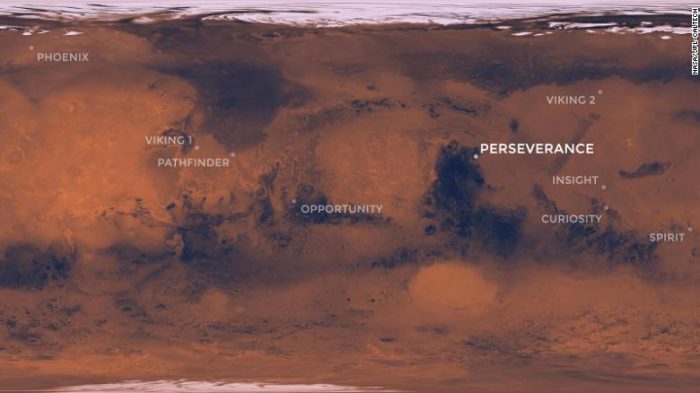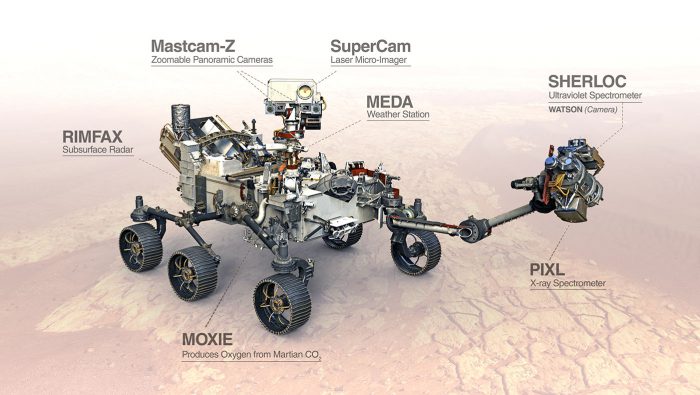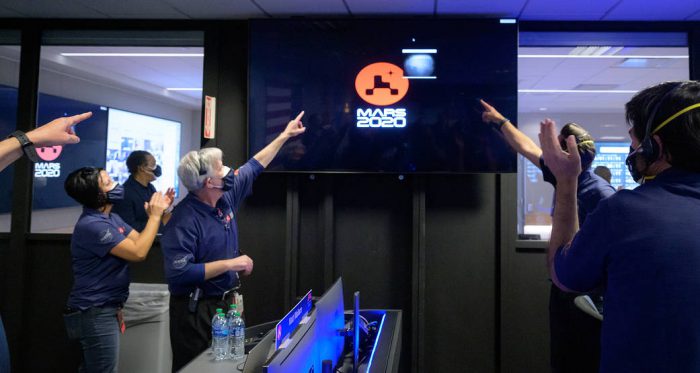On Thursday, February 18, at 3:55pm EST, Mars officially received a new guest. Its name? Perseverance!
Launched last summer, this new NASA rover has been sent to continue the work of current and past Martian rovers Curiosity and Opportunity. But though this new vehicle has some similarities to its ancestors, Perseverance is a much more modern machine. It is the largest, most advanced rover ever sent to another world, and it quickly got to work.
Shortly after touching down, it sent this souvenir back home.
Hello, world. My first look at my forever home. #CountdownToMars pic.twitter.com/dkM9jE9I6X
— NASA's Perseverance Mars Rover (@NASAPersevere) February 18, 2021
Except, Mars is its home now—its move there is permanent. So what can we expect from the Red Planet's newest resident? Let's look closer at its mission.
Jamming in Jezero

This map of Mars shows the landing location of Perseverance, along with the location of all other successful NASA missions to the surface. (NASA)
Perseverance landed in Jezero Crater, a huge depression (or pit) in the surface of the planet that is about 49 km (34 miles) wide. At one time, billions of years ago, scientists believe that Jezero would've been a lake—one that was fed by rivers, which deposited sediment (or mineral-rich dirt) on the bottom of the lake. These characteristics make it an ideal place to investigate the history of Mars.
Especially whether or not Mars ever supported life.
Scientists believe that Mars was once very like Earth—not just full of lakes and rivers, but also much warmer than it is today. (Today, the average temperature of Mars is -62°C or -81°F.) On Earth, life first began billions of years ago in the water. Perhaps this also happened on Mars, too?
This is the main mission of Perseverance. Examine the ancient sediment deposits and rock of Jezero and see what they can tell us about prehistoric Mars.
An amazing machine

This image shows the main components that make up Perseverance. (NASA)
To perform this task, Perseverance comes equppied with lots of cool gadgets. It's essentially a mobile lab. It has the ability to take readings across a bunch of different wavelengths (ultraviolet, x-rays, radar, blue light, and more), to gather samples, and to analyze what it finds.
It can communicate with Earth, create its own power, and use its six wheels to make its way around Jezero. Its weather system, MEDA, keeps an eye on the hostile planet's storms, while another, MOXIE, conducts an experiment to see how well we can make oxygen from the planet's mostly CO2 atmosphere. And it does all of this on a planet that is colder than many of the coldest places on Earth! Remarkable technology!
You can click and drag on this 3D model to check out the rover for yourself.
And to (re)watch all of this tech make a safe landing, check out yesterday's live stream below. (The landing happens around 1:40:00.)
Up and away!
But that's not all! Because maybe the coolest tech on board Perseverance is something that has nothing at all to do with its main mission.
It is called Ingenuity and it is a helicopter drone!
This entirely separate machine actually rode piggy-back under Perseverance's belly for the landing (or is that belly-bottom?). It will be the first vehicle to attempt flight in the atmosphere of another world. To do this, it needs to be both very light and very powerful for its size—the Martian atmosphere is extremely thin compared to ours.
Ingenuity's flight will be both low to the ground and very short in time. Kind of like how the first flights by the Wright Brothers were here on Earth over a century ago! And if successful, they will be just a significant a breakthrough for human engineering.
Learn more about Ingenuity in this video. Here's to many years of awesome science from both of these vehicles!
 They did it! Members of the mission control team celebrate after Perseverance's successful touchdown on Mars yesterday. (NASA/Bill Ingalls)
They did it! Members of the mission control team celebrate after Perseverance's successful touchdown on Mars yesterday. (NASA/Bill Ingalls)










Awesome